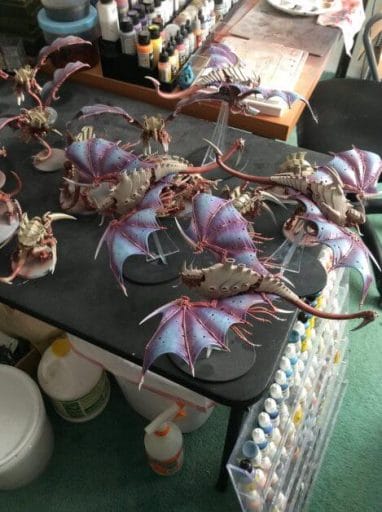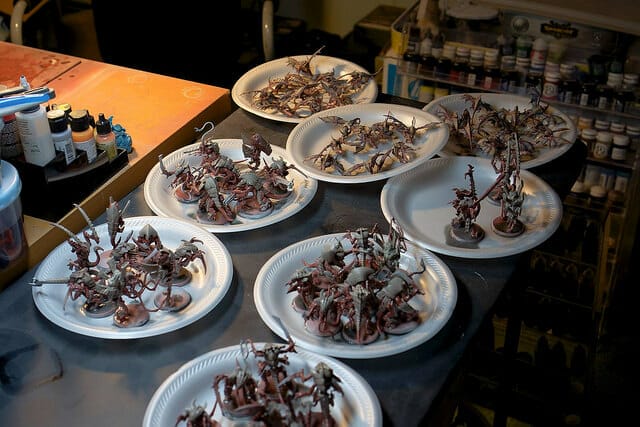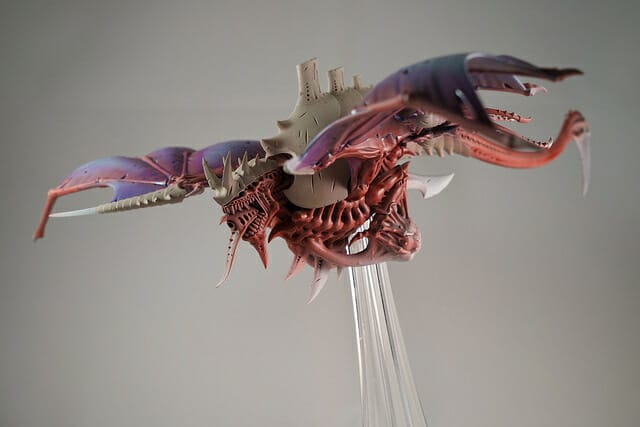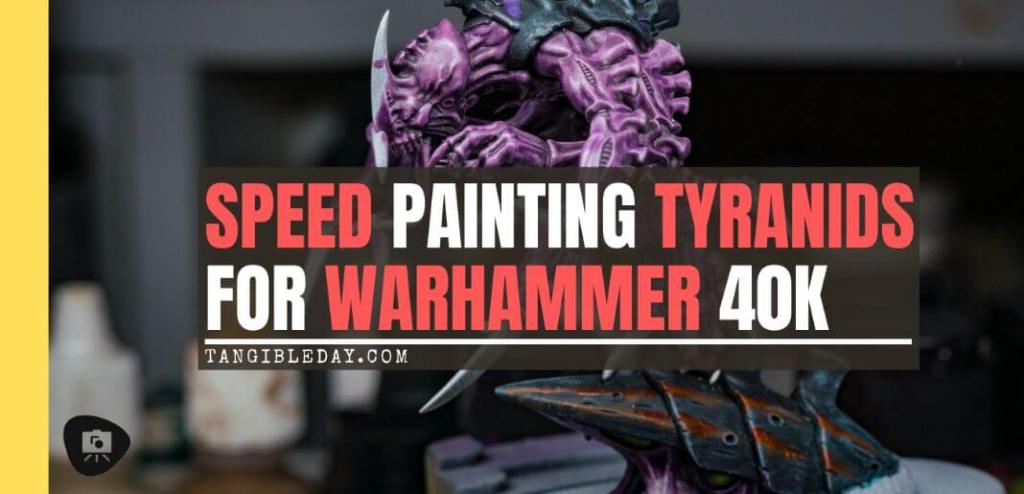Games Workshop produces some of the best sculpts I’ve seen on the market. No surprise given the company’s history. Of my several ongoing commission projects, my task with this Tyranid army (more than ~300 pieces) has been a lesson in patience, endurance, and (most importantly) an enlightening experience.
In this article, I review some of my thoughts on the process and how I paint a large army sized project (Warhammer 40k Tyranids). If you’re looking for a way to speed paint tyranids, then this post may help you!
READ MORE: HOW TO SPEED PAINT MINIATURES, FAST AND SIMPLE METHODS
Tips and Insights into Painting Huge Armies of Miniatures and Models

Whether you’re painting a miniature army of historical military figures, Warhammer 40k tabletop models, or other collection of miniatures, there is always the sense that you’re not going to finish. When you paint models, you’ll discover along the way that there’s always something else you can do. You’re never truly finished.
RELATED: HOW TO BATCH PAINT LARGE MODEL ARMIES
But, I like to think of this lack of a finish line as part of the adventure that never ends. The life of a miniature hobbyist is a continuous walk down a path of discovery, where opportunities to learn something new pop-up in the most unexpected places all the time.
To learn more about my thoughts, insights, and tips about how I approach painting large batches of models read on below!
The Need for Efficiency is More Than Speed
Speed painting an army lot of this size (Tyranid armies use swarm tactics, i.e., overwhelm with numbers) has pushed the limits of my ability to stay organized and efficient. In my usual painting method for solo, or small units, I tend to dance around with color. A Bob Ross approach, where I feel my way through color, contrast, and light.
I’ll note that this particular approach where I organically decide what paint to apply to a model is more than efficiency and speed. Painting dynamically is also more fun. I find that I paint faster, more efficiently, when I’m enjoying the process. Something happens when your brain stops editorializing your work and you’re immersed in that flow state where things just work.
Bottom line: The more enjoyable the process when you’re painting a large number of models, the more efficient you’ll be with your brush, your paint, and your time.
Plan Less, Do More: It’s Okay to be Impulsive
Under typical conditions, I don’t plan. Color schemes “emerge” as I go. This Bob Ross strategy, of course, eats time like an interstellar black hole. Once the primer is placed onto the model, it is an empty canvas and my mind doesn’t really have a clue.
Here, as an example, I’m going back and forth between 3 or 4 colors at the same time, mixing and washing, and dry brushing all in a single step. I may go over some colors with a dark wash to add saturation, for example. I use reference photos and, in some cases, the clients’ instructions and preferences for what they want; but generally, my approach is instinct — pure and simple.
Time is Your Friend and Foe: Embrace Time
Time. Oh, how I loathe, thee. But, when a large army project comes my way as it has on more than one occasion in my side-career as a commissioned painter, I’ve had to set aside a good amount of time to plan. At the very least, I have had to take notes on a sort of “blue-print”. In short, I have to work out these important items, as though I’m planning to build a skyscraper.

This may seem like it goes against what I mentioned above where I encourage you to think less and do more. But, in fact, what I’m really saying is that you should try to have some “vision” of what you want your project results to look like before you start. It doesn’t need to be fully fleshed-out idea or plan for your project. Instead, just have a good sense of what you want to achieve through the work.
If you have a broad outline, a sketch in your head, of what you want to do with your model collection, then when it comes to painting you will less likely get stuck when small problem arise. You’ll be able to focus yourself quickly and return to your pipeline, even when you stumble.
Take a bit of time before you start a project to solidify some quick, sketch-like goals, of what you want to aim for. Then, execute. You’ll save time by spending a bit of time before your project starts. A part of this early planning process is to consider logistics.
The bigger your project, the more important your logistics of working through the project.
Logistics of Speed Painting a Large Number of Models
Questions that I have to answer before I dive into a big project:
- Do I have enough paint?
- Do I have the recipes for the correct color mixes?
- Can I speed up all the base coats with the tools I have on-hand?
In the case of the Tyranid project, I’ve been pushing the envelope.
I’m using not 1 or 2, but 4 airbrushes (badgers, IWATAs) hooked up to a quick-release hose!
RELATED: BEST AIRBRUSHES FOR PAINTING MINIATURES (GUIDE AND REVIEW)
Each airbrush houses a different nozzle size to accommodate the type of paint I’m using (i.e., viscosity of GW paint needs to higher for base coating, etc.).
Using a multi-airbrush system also allows me to disassemble a brush for overnight cleaning in a sonicating cleaner without stopping my workflow.

Speed Painting Tyranids Requires More Than an Airbrush
Of course, painting miniatures doesn’t offer the ease of finishing a project entirely with a single tool. Hence, spraying color with pressurized air only gets a model 50% of the way there.
The last 50% is grunt work: manual labor with a classic brush. For that, I’ve learned through experience that the best approach is to choose the largest caliber brush that will do the job without getting in your way.
It’s insanity to try and paint a monstrosity with a pointed round #2.
Even with most of the color on the model through airbrushing, finishing details with a needle-nosed brush would take forever. So what I use for closer brush work is to use a flat headed brush (my current favorite is the Citadel Medium Base brush).
RELATED: BEST BRUSHES FOR PAINTING MINIATURES
Not only do these brushes allow you to cover more surface area with each brushstroke, they also hold more wet paint in the “belly” of the brush hairs.
This means I’m hitting the paint pot, or palette (dry or wet) less often. And believe it or not, those few seconds that I’m not busy reloading and dabbing for more paint, add up into many saved hours!
Well, using a big brush to some people may mean that I get sloppier. Not really.
With a high quality brush, the tufts hold their shape (they don’t splay out) and give me good precision with careful paint viscosity control.

How to Paint Faster
So when it comes to speed, I’ve learned that choosing the right tools for the job is key (more about bout speed painting here).
Funny enough, a veritable factory of instrumentation I’ve collected has given me that enlightening knowledge of how many commercial industries function.
Production factories, the cornerstone of consumerism, use workflows that have developed over years and years. The image of conveyor belts and robotic arms welding an assembly line of cars comes to mind.
In short, from the first model I ever painted (a Cygnar Ironclad Warjack) until now (a giant-sized tyranid army), I think I’ve fallen into the desktop version of a modern factory conveyor belt.
My system incorporates the absolute best, quality control system: my eyes, the beholder of beauty. Everything I deliver has my personal seal o’ approval.

Final Thoughts
Well, painting a large army isn’t easy. But, it can be fun and doable with a slightly different perspective on things. I’ve written a lot on this site about the right tools and how to create productive workflows for the hobby.
Here are a few articles specifically discussing how I speed paint armies for different projects. I hope they give you some new perspectives in how you can approach your miniature painting projects with an eye for efficiency and productivity.
- How I Speed Paint Miniatures (Thoughts and Ideas)
- Speed Painting RPG and Board Game Miniatures
- Using the Dipping Method to Quickly Paint Miniatures
- Batch Painting Miniatures (Guide)
I hope you found this post helpful. If you have other ideas and feedback, I’d love to hear from you. Please leave a comment below!



Tangible Day on YouTube (Miniatures and More!)


They look awesome dude congrats
Pingback: Speed Painting Tyranid Swarms (Tips and Process for Painting Large Armies) - Toy Newz